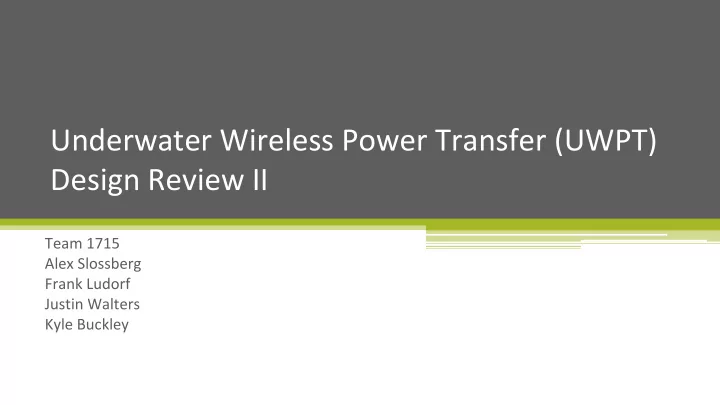

Underwater Wireless Power Transfer (UWPT) Design Review II Team 1715 Alex Slossberg Frank Ludorf Justin Walters Kyle Buckley
Overview Of Project 1. Summary 2. Hardware a. Coil Driver b. Rectification and Boost Converter 3. Control System a. Microcontroller b. Machine learning 4. Testing Setup a. New Rig 5. Experimental data
Scope of Design ● Continuation from 2015-2016 Senior Design ● Last years accomplishments ○ Transmitted 12VAC at 19 kHz using H bridge ● 2016-2017 Improvements ○ Transmit 33 VAC bandwidth 150kHz-1MHz using amplifier ○ DC/DC Converter ○ Control System ○ Precision Testing Frame
Applications • AUVs recharging • Wave energy / Solar converters • Underwater sensor recharging • Buoy recharging
Experimental Setup
Simplified Network Receiver Transmitter Series Series Compensation Resonant Frequency of RLC circuit
Final Coil Design • Flat spiral coil • Identical pair • Copper magnet wire • 3D printed base • Self inductance measured = 70uH at 150kHz • Calculated = 77.8uH
Op-Amp PA94 Bandwidth 20kHz-1MHz Transmitter Circuit Voltage P-P 38V-28V Max Voltage P-P 900V Current Output 50mA Current Max 100mA Gain 17.4 Slew Rate 600V/us
Receiver Circuit: Full Bridge and Boost
Ideal Control System • Using an ATmega328p chip to handle the control system Process • Generate K values beforehand based on circuit values • Read the secondary sides current and voltage via two ADC reads • Duty cycle is then adjusted to achieve Voltage Characteristics maximum efficiency
Actual Control System Process • ATmega328p changes the duty cycle • Examine the voltage change • Adjust the duty cycle accordingly for set voltage Reasons we used this system • Changed for simplicity
Testing Setup • Modeled in SOLIDWORKS • Precision alignment of coils for test • Increased coil turns and outer diameter • Corrosion resistant materials ▫ Nylon threaded rod, 3d printed plastic • Non magnetic at coil interface
Measured Voltage Vs. Distance Parameter Value Frequency 300 kHz Period 3.33 ns Input Voltage 28 VAC Rail Voltage +- 30VDC Forward 300 mV Voltage Compensating 12nF Capacitor
Measured DC Voltage Before DC/DC Boost Converter Parameter Value Frequency 300 kHz Period 3.33 ns Input Voltage 28 VAC Rail Voltage +- 30VDC Forward 300 mV Voltage Compensating 12nF Capacitor
Measured Voltage after DC/DC Boost Converter As distance increases our ability to boost the voltage is limited Parameter Value Frequency 150kHz Period 6.66 ns Input Voltage 28 VAC Rail Voltage +- 30VDC Forward 300 mV Voltage Compensating 12nF Capacitor
Budget Report Total Budget: $1000 Remaining : $213.12
Hardware Improvements • Active rectification ▫ Eliminate forward voltage drop • Driver stage for op-amp ▫ Increased current gain • Monolithic function generator IC: XR-2206 ▫ Independent sine generator ▫ Or use microcontroller
Questions?
Recommend
More recommend